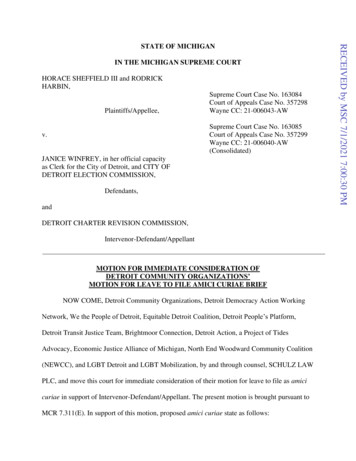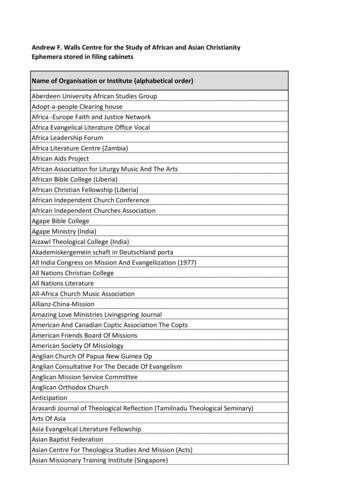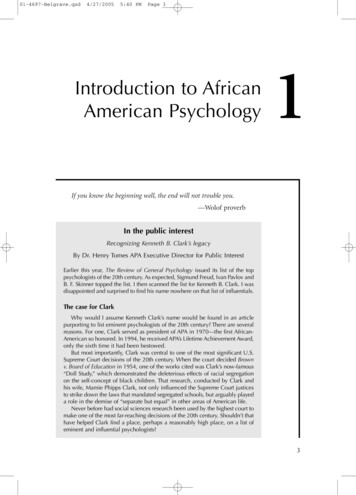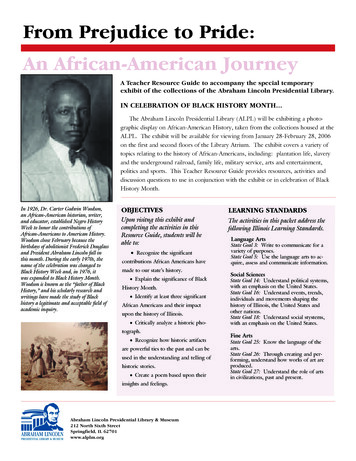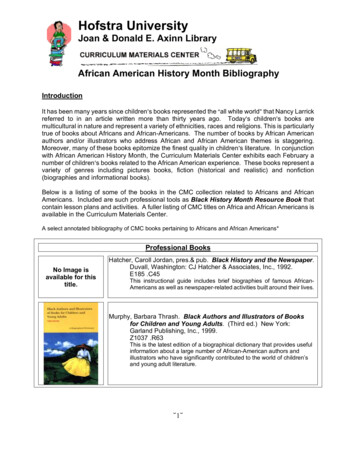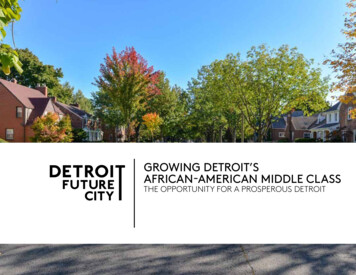
Transcription
GROWING DETROIT’SAFRICAN-AMERICAN MIDDLE CLASSTHE OPPORTUNITY FOR A PROSPEROUS DETROIT
GROWING DETROIT’SAFRICAN-AMERICAN MIDDLE CLASSTHE OPPORTUNITY FOR A PROSPEROUS DETROITPhotographyTafari Stevenson-Howard1st Printing: February 2019
GROWING DETROIT’SAFRICAN-AMERICAN MIDDLE CLASSTHE OPPORTUNITY FOR A PROSPEROUS DETROIT
4FOREWORDForewordThere’s a simple, universal concept concerning economic, social and educational growth that must be front of mind inplanning about enlarging the black middle class: Authentic development and growth require deliberate investment. If wewant to see more black people enter the middle class, we must invest in endeavors and interventions that lead to betterpaying jobs, affordable housing, efficient transportation and effective schools. Though these amenities will attract middleclass people back to Detroit, the focus on development must be directed at uplifting a greater percentage of currentresidents so that they have the necessary tools to enter the middle class. Meaning, growing the black middle class inDetroit should not result from pushing low-income people out of the city.One may think a strategy to attract people back into to the city should take priority. White and middle-class flightsignificantly influenced the concentrations of families who make less than 50,000 in the suburbs (30 percent) and inDetroit (75 percent), according to findings in Detroit Future City’s “139 Square Miles” report. Bringing suburbanites backinto the city would alter these percentages, and we most certainly want conditions that are attractive to all middleclass families. However, we also don’t want to return to the realities where the devaluing of low-income and black peoplehastened the flight to the suburbs. The concentration of black people who stayed in the city is an asset that’s worthy ofinvestment. Increasing the percentage of the black middle class is vitally important. But building from within is more so.Detroit Future City’s report “Growing Detroit’s African-American Middle Class” is a deliberate investment that recognizesthe inherent value in the people who make Detroit great.Andre M. PerryDavid M. Rubenstein Fellow, The Brookings InstitutionAuthor of “Know Your Price: Valuing Black Lives and Property in Black Cities”
ForewordAt Knight Foundation, we believe that informed and engaged communities are essential to a well-functioning,representative democracy. This mission is guided by our support for free expression, journalistic excellence, civicengagement, and equitable, inclusive and participatory communities. It is built upon the vision of our founders,John S. and James L. Knight, newspaper publishers who were deeply committed to presenting the full, actual,contextual truth in service to their communities.It is with our mission in mind that Knight Foundation is pleased to support Detroit Future City’s publicationof “Growing Detroit’s African-American Middle Class: The Opportunity for a Prosperous Detroit.” At a time ofcontinuing transformation for Detroit, it is important to consider our city’s history, its present and the opportunitypresented to build a more prosperous city from that heritage. Each page of this report presents an opportunity todiscuss who we are as a city, how we’ve gotten here, and what we should do to move forward. Those importantdiscussions among Detroiters are exactly why we value this report and others like it.All Detroiters deserve to be empowered with information that is open, accessible and verifiable. To effect change,residents, policymakers, journalists, civic leaders, business owners, and activists need to work together using acommon set of facts. With this in mind, “Growing Detroit’s African-American Middle Class” can be an impetus forconstructive discussion and robust debate.Katy LockerDirector/DetroitJohn S. and James L. Knight Foundation5
RDTFABlanche and Booker Goings
Detroit Future City is proud to introduce “Growing Detroit’s African-American Middle Class: The Opportunity for a ProsperousDetroit,” an in-depth look at the quantitative and qualitative aspects of African-American middle-class households and the valuethat the African-American middle class provides to communities.My grandmother, Blanche Martin Goings, arrived in Detroit in 1941 from Lafayette, Alabama. A recent graduate from AlabamaTeacher’s College, she was confident that she would make a living as a teacher in this bright, gleaming new city. Unfortunately,her teaching certificate was not recognized by the State of Michigan, but she was offered a position as a teaching assistant.Shortly thereafter, she met my grandfather, Booker Goings, a janitor for the Department of Public Works for the City of Detroit.They soon married and rented their first home on Detroit’s west side, later purchasing a modest Tudor nearby. They had fivechildren; four went on to college, and one served in the Vietnam War. They are the American middle-class story in Detroit.This report was borne out of “139 Square Miles,” a comprehensive data report Detroit Future City published in 2017 analyzingDetroit’s people, economy and places. We decided to focus on the middle class as a continuation of that report because onespecific data point worried us here at DFC: More than 75% of Detroiters make less than 50,000, that is in stark comparisonto the region, where only 30% of households make less than 50,000. The decision became obvious. Detroit’s success waspredicated on increasing the number of middle-class households. However, this was not a simple attraction strategy; this hadto be a combination of attracting, growing and retaining African-American middle-class households. The question then becamehow to capture that strategy in an accessible data report. Understanding and defining Detroit’s African-American middle-classpopulation was a heavy but important lift. It is a personal narrative about families, choices, opportunity and decisions.As with “139 Square Miles,” this report will focus on demographics, economic development and place. Unlike “139 Square Miles,”Detroit Future City will share its opinions and policy recommendations that we hope the reader will use to draw his or her ownconclusions and strategies. We also spent time with a number of current, former and future Detroiters in focus groups. Theirvoices are incorporated into this report to balance the data with personal perspectives. This personal voice was one of the mostimportant components. Whether the Detroiters who spoke with us were below, in the middle or above the economic incomemarker, they all identified with being middle class, not unlike my grandmother when she got off the bus from Lafayette, Alabama.As Detroit Future City continues to do our best to keep Detroiters informed and engaged in Detroit’s continued growth, we hopeour new report, “Growing Detroit’s African-American Middle Class: The Opportunity for a Prosperous Detroit,” is useful, thoughtprovoking and personal.Enjoy,Anika Goss, Executive Director of Detroit Future CityFOREWORDForeword7
Design Team:Detroit Future CityMass EconomicsKurt Metzger and AssociatesVan Dyke Horn Public RelationsMedia GenesisSaga MarketingMichigan State University, InnovateGovAdvisory Group:David Blaszkiewicz, Invest Detroit, Detroit Future City board memberSam Butler, Doing Development Differently in Metro DetroitChase Cantrell, Building Community ValueWendy Jackson, The Kresge Foundation, Detroit Future City board memberCatherine Kelly Former Publisher Michigan CitizenCecily King, Live6 AlliancePam Lewis, New Economy InitiativeLaura Trudeau, Detroit Future City board chairAlice Thompson, Black Family Development Inc., Detroit Future City board memberFunder:Knight Foundation Fund of the Community Foundation of Southeast MichiganACKNOWLEDGMENTSAcknowledgments9
10CONTENTSContentsIntroductionA New Metric for EquityWhat is Middle Class?The Middle Class in DetroitMiddle-Class NeighborhoodsMiddle-Class African-American NeighborhoodsNear-Middle-Class NeighborhoodsGrowing, Retaining and Attracting Detroit’s Middle ClassDetroit’s ChallengesPolicy Strategy Detroit’s Opportunity to Grow the Middle ClassConclusionAppendix, Notes and Citations122022243339414247586570
CONTENTS11
12INTRODUCTIONIntroductionAcross the nation, there are more than 45 million middleclass households, of which 4.6 million are headed by AfricanAmericans. Detroit Future City (DFC) defines a middleclass household as one having an income between 80%and 200% of the national median household income. Thistranslates to household incomes between 46,100 and 115,300 per year.This report will take a close look at the middle class inDetroit, with a special emphasis on the African-Americanmiddle class. DFC’s goal is to focus attention on thisimportant demographic group and foster a broader civicconversation about how growing the African-Americanmiddle-class is key to growing an equitable andprosperous city.MiddleClassIt is said that Detroit gave birth to the American middleclass when, in 1914, the Ford Motor Company began payingfactory workers a then unheard of 5 per day. These good-paying manufacturing jobs fueledU.S. economic prosperity for blue- and white-collar workers alike. Strong industrial tradeunions, such as the UAW, set a standard for wages and benefits that provided economicstability to a broad cross-section of families throughout much of the 20th century.
In the years following World War II, the country began an era of widespread suburbanization. Olderindustrial cities such as Detroit experienced significant population losses as white households movedto the suburbs. 13INTRODUCTIONDetroit was especially important to the rise of the African-American middle class. Beginning in theearly 1900s, Detroit, like many other major U.S. cities, became a magnet for African Americans,many of whom were moving north as part of the Great Migration in search of jobs. AlthoughAfrican-American manufacturing workers faced discrimination in hiring and promotions, Detroit’seconomy still generated large numbers of good-paying jobs for blue-collar workers of all races1.Business ownership was another source of middle-class incomes for African Americans by the early1950s. In his book “The Origins of the Urban Crisis,” Thomas Sugrue noted that “Detroit boasted thelargest number of independently owned black businesses of any city in the United States.”2 Later, asmanufacturing jobs in Detroit declined, some African-American workers found middle-class positionsin the public sector, serving as teachers, firefighters and police officers.3
Detroit Households by Income, 1950-20171460%INTRODUCTION50%As the region expanded and the suburbs grew,they pulled middle-class families from Detroit,a key factor in the city’s decline. Even thoughthe prevailing story of Detroit is the rise of thesuburbs and decline of the city, in the later partof the 20th century, though the number of whiteresidents fell substantially, the African-Americanpopulation remained restively stable.However, in the first decade of this century,that trend reversed, with population declinein the city led by a shrinking African-Americanmiddle class. Though some of this decreasewas due to declines in household size, much ofit can be attributed to the movement of theAfrican-American middle class out of the city tonearby suburbs, such as Southfield, Oak Park,Eastpointe, Harper Woods, Lathrup Village andRedford Township. As a result, Detroit now hasa disproportionately small share of middle-classhouseholds relative to the rest of the region.40%30%20%10%019501960Less than Middle Class2000Upper Middle Class2017300%NationalMedianSource: Analysis of U.S. Census 1950-2010 and American CommunitySurvey, 2013-2017Population by Race, 01980African American1990200020102017WhiteSource: U.S. Census 1970-2010 and American Community Survey,2013-2017
The decline of the middle class, regardless ofrace, is not unique to Detroit. In recent years,the decline of middle-class incomes has beena frequent topic of national discussion. Thoughthe definitions used by researchers to track themiddle class vary slightly, there is a growingbody of research that has consistently founda substantial decline in the middle class. Forexample, the Pew Research Center found that themiddle class made up 61% of U.S. households in1970, but only 50% by 2015.4In his 2018 book, “The Divided City,” author AlanMallach found that the share of middle-classhouseholds dropped from 43% to 24% over thesame period.5 Using DFC’s definition, the share ofmiddle-class households in the United States hasdropped from 43% to 38% between 1970 and 2017.The share of middle-class householdsin the United Stateshas dropped from43%to38%between 1970 and 2017Currently, 25% of Detroit’s households can beconsidered middle class. This compares to 38% inthe larger Metro Detroit region.6 To bring Detroit’sshare of middle-class households in line with theregional share, an additional 33,800 middleclass households of all races would be needed.To ensure that Detroit is growing equitably, it isimportant that the share of middle-class AfricanAmericans is brought in line with that of theregion, as well.INTRODUCTION15
16INTRODUCTIONThat would require an increase of 27,700 AfricanAmerican middle-class households in Detroit. Thisgrowth could include any combination of attractingnew middle-class households, retaining middle-classDetroit households, or moving Detroit householdsfrom lower-incomes to middle-class incomes.For the first time in decades, Detroit is poised forpopulation growth. The number of households in thecity is increasing, and there are early indications thatthe number of middle-class households is beginning toincrease.7 Though this is not a trend that is universalacross the city, there are areas that are stabilizing andtaking steps in the long path toward revitalization.For growth to occur in an equitable and inclusivemanner, it is imperative that current Detroit residents,particularly African Americans and other peopleof color, are able to fully participate in the city’srevitalization. This will require deliberate action. Assuch, key components of the city’s growth must beintentionally focused on the African-American middleclass in order to grow the middle class from within,as well as create quality middle-class neighborhoodsthat will retain and attract middle-class households.Detroit needs33,800 MOREmiddle-class householdsTO HAVE THE SAME SHARE OFmiddle class as the region
This report focuses on the African-Americanmiddle class for two reasons.First, Detroit Future City’s 2017 “139 SquareMiles” report showed that nearly 75% of Detroithouseholds had an income of less than 50,000.By contrast, only 30% of regional and U.S.households earn less than 50,000 per year.Second, since the turn of the 21st century,middle-class African Americans have been thelargest demographic group to move out ofthe city to nearby suburbs. Increasing Detroit’sAfrican-American middle-class households tothe regional and national levels, and reversingthe loss of Detroit’s African-American economicbase, create a clear challenge worth furtherresearch and analysis. The focus on these twoprimary issues can lead to the development ofinclusive growth and prosperity strategies thatcould benefit all Detroiters.INTRODUCTION17
18INTRODUCTIONMiddle-class neighborhoods could be animportant part of the city’s revival. In Detroit, asin other cities across the country, middle-classneighborhoods tend to be stable, with 49 of the50 largest cities, including Detroit, experiencinggrowth within middle-class neighborhoodssince 2010. Between 2010 and 2017, the numberof total households in Detroit decreased 5%,while the number of households in middle-classcensus tracts increased 8%.8 When comparedto the other 49 largest American cities, Detroitranks 19th in the rate of growth in households inmiddle-class census tracts.In the creation of this report, Detroit FutureCity and the project team took a deep diveinto the available data to examine the trendsand issues currently facing the city of Detroitand its middle-class residents. In addition,Detroit Future City also convened a series offocus groups to gain a deeper understandingof the African-American middle class and theirexperiences in Detroit and across the largermetropolitan region.D E T RO I Tranks 19th in therate of g row t hOF HOUSEHOLDS INMIDDLE-CLASS CENSUS TRACTS
Shareof MiddleClassinHouseholdsPercentageChangeHouseholds inin Middle 017Miami, FLNew Orleans, LAFort Worth, TXDallas, TXDenver, COEl Paso, TXCharlotte, NCHouston, TXOklahoma City, OKSeattle, WAJacksonville, FLAustin, TXNashville, TNLas Vegas, NVSan Antonio, TXRaleigh, NCColumbus, OHAtlanta, GADetroit, MIWashington, D.C.Boston, MAPortland, ORMesa, AZSan Francisco, CALouisville, KYColorado Springs, COKansas City, MOPhiladelphia, PASan Jose, CAPhoenix, AZMilwaukee, WIMemphis, TNChicago, ILSacramento, CAIndianapolis, INCleveland, OHTulsa, OKLos Angeles, CAArlington, TXSan Diego, CAOmaha, NEFresno, CABaltimore, MDWichita, KSVirginia Beach, VAMinneapolis, MNAlbuquerque, NMLong Beach, CANew York, NYTucson, AZOakland, CA8.3%-5%0%5%10% 15% 20% 25% 30% 35% 40%Source: Analysis of American Community Survey,2006-2010 and 2013-2017
20A NEW METRIC FOR EQUITYA New Metricfor EquityAs much of the redevelopment in the cityhas occurred in the Greater Downtown andsurrounding neighborhoods, there are questionsabout who is benefiting from the revitalizationof Detroit. A recent survey by the University ofMichigan found that 52% of respondents believethat white residents benefit more than AfricanAmericans, and 74% believe that wealthyresidents benefit more than poor ones.9 Thissentiment was also echoed by the focus groupsconvened for this report.One question that frequentlyARISES IS HOW TO MEASUREwhether Detroit, a cityTHAT IS 79% AFRICAN AMERICAN,is growing equitably.One simple measure would be to track thegrowth of the African-American middle classwithin the city. This metric captures manyaspects of the revitalization. First, this metricwould track how well African-Americanhouseholds in the city fare in terms of incomerelative to other households in the city andsurrounding communities. Second, it could beused as an indicator of how neighborhoodsacross the city are revitalizing and becomingmore desirable places for the middle class tolive. The combination of these two elementswould make tracking the number of middle-classAfrican American households in Detroit a simpleand effective metric to track equitable growth inthe city.
22WHAT IS MIDDLE CLASS?What is Middle Class?The term “middle class” has many connotationsbeyond a simple statistical metric to describe anincome group. For the purposes of this report,Detroit Future City is defining the middle classas those living in households with a householdincome between 80% and 200% of the nationalmedian household income.Using the 2017 American Community Survey, thistranslates to households earning between 46,100and 115,300 per year. Similarly, we define the“upper middle class” as those living in householdswith incomes between 200% and 300% of thenational median household income, or 115,300 to 173,000 per year.NearMiddle Class50% MedianHouseholdIncome: 28,800Middle Class80% MedianHouseholdIncome: 46,100UpperMiddle Class200%MedianHouseholdIncome: 115,300300%MedianHouseholdIncome: 173,000
When asked to describe what it means to bemiddle class, DFC’s focus group participantsresponded that it implies a sense of comfort andsecurity. They also said that being middle classallowed them to purchase some of the thingsthey desired, but not all of them. However, theyfelt that their economic security was fragile andfeared that they could easily lose their middleclass status. There was also a sense that thefate of middle-class households is overlookedin many policy debates and decisions. Focusgroup participants saw themselves, and othermembers of the middle class, as making toomuch money to qualify for support programsgeared toward lower-income households, butnot enough to afford true economic security ora place in the newly developing areas of Detroit.WHAT IS MIDDLE CLASS?23
24THE MIDDLE CLASS IN DETROITThe Middle Classin DetroitThere are 64,700 middle-class households livingin the city of Detroit. Additionally, there are9,000 households that can be classified as uppermiddle class.Household Income, 201760%51%50%40%Nationally, there are 45.6 million middle-classhouseholds and 13.6 million upper-middleclass households, accounting for 38% and 11%of the nation’s households, respectively. Theseshares are equivalent to what we find in theMetro Detroit region. In the city of Detroit,however, the middle class accounts for only 25%of households, with just 3% considered uppermiddle class.38% 38%30%25%26%25%19%20%16% 16%11%10%12%9%3%0 50% NationalMedianUnited States50%-80% NationalMedianMetro DetroitMiddle ClassUpper Middle Class9%2% 300% NationalMedianDetroitSource: Analysis of American Community Survey, 2013-2017
Middle Class by Age of Householder, 2017Middle Class by Age of Householder : 201760%In Detroit, the age of middle-class householders trends slightly older than in the region 50%and nation. Nevertheless, the largest share inall cases is held by households headed by an40%individual 45 to 64 years old, accounting for43% of all middle-class households. The secondlargest group is those 25 to 44 years, at 31%. 30%50%51%42%43%40%40%36%38% 38%33%31%30%25%26%25%19%20%21%23% 23%THE MIDDLE CLASS IN DETROIT2516% 16%20%11%10%12%10%0 50% National3%Median2% 2%0%United StatesUnder 25 years50%-80% NationalMedianMetro Detroit25 to 44 yearsUnited StatesMiddle ClassDetroit45 to 64 yearsMetro Detroit65 years or olderDetroitSource: Analysis of American Community Survey, 2013-2017Upper Middle
26THE MIDDLE CLASS IN DETROITThough Detroit’s share of middle-classhouseholds is small relative to the region andthe nation, it is also smaller than any majorcity in the country. Compounding that, Detroitalso has the largest share of low-incomehouseholds, with slightly more than half itstotal households making less than 50% of thenational median income.Detroit,MIDetroit,MI Middle-Class Households for ami,Miami,FLFLFLMiami,FL50 Largest U.S. Cities, giniaBeach, ladelphia,PARaleigh, NCTucson,AZAZTucson,Tucson,AZTucson,AZArlington, TXFresno,CACAFresno,Fresno,CAFresno,CAFort Worth, Colorado Springs, COPaso,TXTXElPaso,ElElPaso,Paso,TXElTXNashville, TNTulsa,OKOKTulsa,Tulsa,OKTulsa,OKMesa, ianapolis,INColumbus, OHAtlanta,GAGAAtlanta,Atlanta,GAAtlanta,GALas Vegas, NVChicago,Chicago,Chicago,ILIL ILChicago,ILAustin, , FLHouston,TXTXHouston,Houston,TXHouston,TXOmaha, erque,NMLong Beach, e,KYSacramento, ,MOSan Diego, ork,NYNewYork,NYPhoenix, apolis,MNMinneapolis,MNWichita, nville,FLFLFLJacksonville,Denver, le, KY NVLasVegas,NVMinneapolis,MN is, IN osAngeles,CADenver,CODenver,Denver,COChicago,IL CODenver,CO0 5%SanJose,15%SanJose,CASanJose,CANew Orleans, LA 0%0%10%20%30%40%50%60%0% 10%10% 20%20% 30%30% 40%40% 50%50% 60%60%0%10%20%30%40%50%60%San Francisco, CAMiami, FL25%Detroit, MI01020304050Source: Analysis of American Community Survey, 2013-2017
Share of Households with Income Less than50% National Median Income, 201751%27Nearly 80% of middle-class households inDetroit are headed by African Americans, some51,400 households. In addition, there are 8,000white 10 middle-class households and nearly3,600 Hispanic middle-class households inthe city.11 Though there is a substantial racialdisparity between the share of middle-classhouseholds across the region and country,in Detroit there is little difference. Across theregion, there is an 11-percentage-point gapbetween the share of white middle class andAfrican-American middle class. In Detroit, thegap is only 2 percentage points. In Detroit,white, African-American and Hispanic middleclass households all have a smaller share thanin the region and nation as a whole.15%0%10%20%30%40%50%60%Source: Analysis of American Community Survey, 2013-2017THE MIDDLE CLASS IN DETROITDetroit, MIMiami, FLNew Orleans, LAMemphis, TNMilwaukee, WIPhiladelphia, PATucson, AZFresno, CABaltimore, MDEl Paso, TXTulsa, OKIndianapolis, INAtlanta, GAChicago, ILDallas, TXHouston, TXAlbuquerque, NMLouisville, KYWichita, KSBoston, MAKansas City, MOSan Antonio, TXColumbus, OHNew York, NYLos Angeles, CAMinneapolis, MNSacramento, CAJacksonville, FLPhoenix, AZOklahoma City, OKLas Vegas, NVOakland, CAMesa, AZLong Beach, CAOmaha, NENashville, TNFort Worth, TXPortland, ORDenver, COWashington, D.C.Arlington, TXCharlotte, SCColorado Springs, COAustin, TXRaleigh, NCSan Francisco, CASan Diego, CASeattle, WAVirginia Beach, VASan Jose, CA
28Since 2000, there has been a dramatic shift inthe number and location of the region’s middleclass households.During this period, the number of middle-classhouseholds in the region declined 9%, andthe number of middle-class African-Americanhouseholds fell 13%. Geographically, this declinehas been centered in Detroit, where the numberof middle-class households, regardless of race,has decreased by 44%.1250%40%40%Middle 41%Class by Age of Householder : 201738% d StatesTHE MIDDLE CLASS IN DETROITPercentage Middle Class by Race, 2017Middle Class by Race 2013 - 201730%20%Middle Class by Race in Detroit, 201721%23% 23%20%10%10%0%10%20%30%African 0%Source: Analysis of American Community Survey, 2013-20170%2%2%WhiteUnder 25 yearsAfrican American25 to 44 years45 to 64 yearsUnited StatesMetro MIDetroitUnited StatesDetroit-Warren-Dearborn,Metro AreaHispanic65 years or olderDetroitDetroit city, MichiganSource: Analysis of American Community Survey, 2013-2017
departure of middle-class African Americanshas resulted in the share of the region’s AfricanAmerican middle-class households living in thesuburbs rising from 28% in 2000 to 54% today.13Change in African-American Households, -70,000DetroitMetroMetro(excluding Detroit)African-American HouseholdsWayne(excluding Detroit)OaklandMacombAfrican-American Middle-Class HouseholdsSource: U.S. Census, 2000 and American Community Survey, 2013-201729THE MIDDLE CLASS IN DETROITThere was an overall decline in the number ofAfrican-American middle-class households inthe region, however, the larger story is the shiftof the African-American middle class householdsout of Detroit to the suburbs. The continued
Middle-Class African Americans Middle-class African-American households Upper-middle-class African-American households2.5510 milesSource: American Community Survey, 2013-2017N
200%As Detroit moves forward, it will be critical to growthe middle class. One group within the city thatwill be important for achieving this goal is the19% of households just below middle-class status.These households currently have incomes between50% and 80% of national median income, which isbetween 28,800 and 46,100. A strong focus onincome growth for this group would help ensurethat current residents are able to fully participateand benefit in the city’s recovery, and that Detroitgrows a strong base of middle-class householdsthat can anchor broader population and incomegrowth in the city.UpperMiddle ClassMiddle ClassThe group ofnear-middle classrepresents anopportunity togrow themiddle class.80%NearMiddle Class50%31THE MIDDLE CLASS IN DETROIT300%
The idea of a middle-class neighborhoodis one that evokes many emotions. Focusgroup participant
Detroit (75 percent), according to findings in Detroit Future City's "139 Square Miles" report. . Kurt Metzger and Associates . Media Genesis Saga Marketing Michigan State University, InnovateGov Advisory Group: David Blaszkiewicz, Invest Detroit, Detroit Future City board member Sam Butler, Doing Development Differently in Metro Detroit

